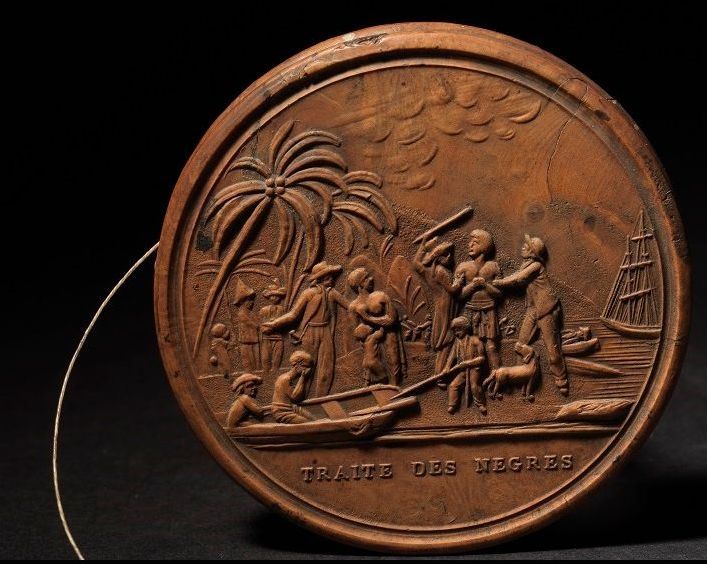
The two sides of this toy for adults present two diametrically opposed visions of a society that was slave-owning at this time: on the obverse, the “Negro trade” (Negro Slave Trade) is inspired by the painting by the Englishman George Morland (1763-1804), Execrable Human Traffic (1788). The artist shows and denounces the violence linked to the deportation of Africans to the West Indies. On the reverse of the toy, a “village festival” illustrates the prosperity and simple pleasures of a carefree European population.
Abolitionist “emigrette” toy
France, late 18th – early 19th century
Ebony wood
Musée Le Secq des Tournelles - RMM. Inv. LS.2001.1.27
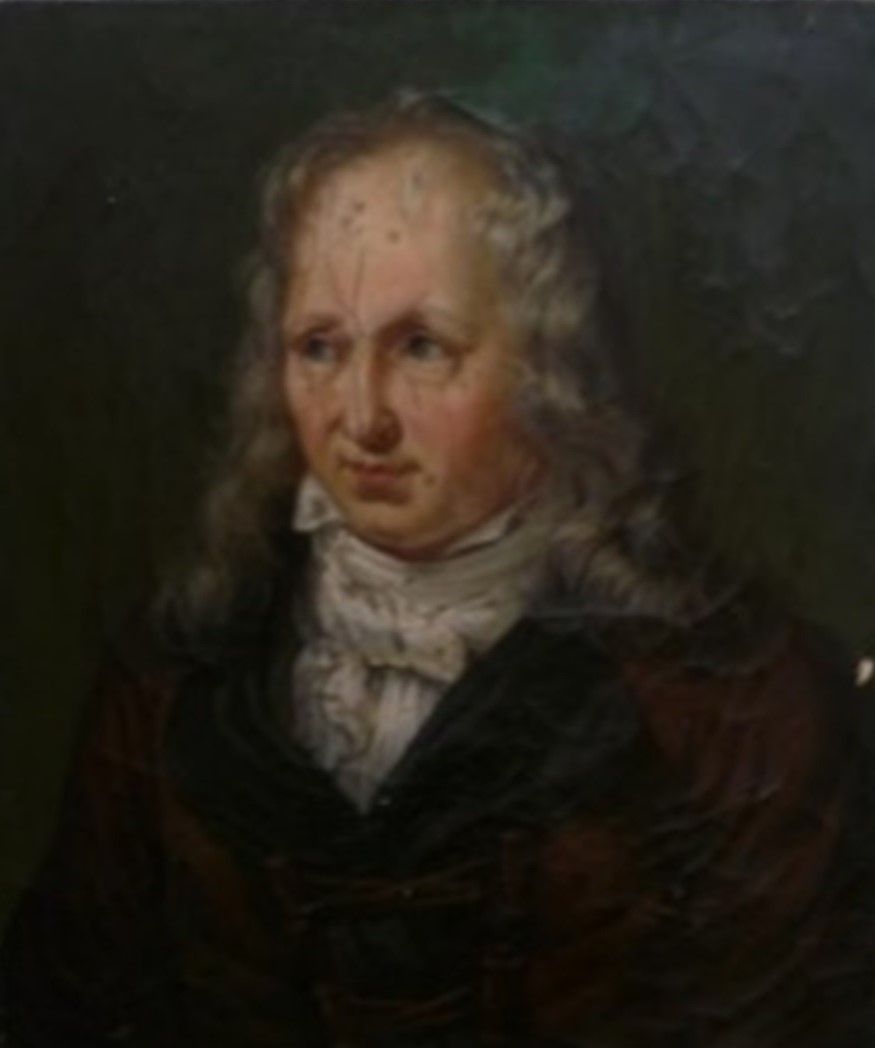
In 1773, Bernardin published his Voyage à l’Isle de France (Voyage to Isle de France, now Mauritius) after a two-year stay in the French colony. He made it his duty to talk about the reality of slavery, insisting on the need for its abolition because of the tyranny of the masters. He highlights the gap between legislation and the reality on the ground, arguing the economic interest that slave labor is more costly than the employment of free workers. In addition, the author appeals to morality, seeing servitude as a factor in moral decline, both for the master who behaves as a torturer and for the enslaved person who is reduced to the status of an object.
CARPENTIER Paul Claude Michel
Portrait of Bernardin de Saint-Pierre
France, 1847
Oil on canvas
Rouen, Musée des Beaux Arts, Département des Peintures, inv. 1851.2.5

In this lithograph entitled “The Boxers”, Géricault illustrates the racist context of the time as well as his own political ideals. In it, he contrasts the opponents as if in a mirror; the black and white of the bodies and clothes are mirrored. This opposition is also reflected in the faces: the oblique profile of the Afro-descendant boxer contrasts with the “Greek” – straight – profile of his Caucasian opponent. This morphological reinterpretation both reflects and denounces the racist view of the time. Géricault chooses to place the two men in the position of equals: he thus is setting out a new social contract for an egalitarian society despite racial prejudice.
GÉRICAULT Théodore (1791-1824 ),
The Boxers
Paris, 1818,
Lithograph
Rouen, Musée des Beaux-arts, Département des Arts Graphiques, inv. AG.X.243
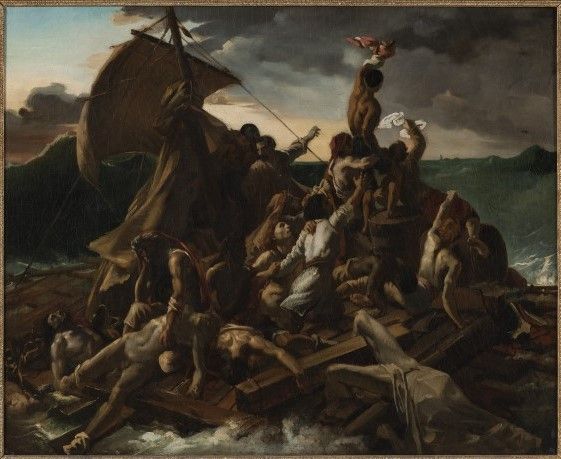
The invention and late inclusion of three African characters among the last survivors of the Raft is the result of Géricault’s awareness of the realities of the slave trade and its crimes. In an 1842 press article, the art critic Charles Blanc (1813-1882) proclaimed: “[…] What! This Negro is no longer in the hold, and it is he who will save the crew! Don’t you admire how this great misfortune has restored equality among the races! [...] It is a noble idea to have reversed the roles!” Géricault restored the dignity of the Afro-descendant figure by giving him the role of hero, placed at the top of the human pyramid.
Anonymous, after GÉRICAULT Théodore
The Raft of the Medusa
France, after 1819
Oil on canvas
Rouen, Musée des Beaux-Arts, Department of Paintings, inv. 1888.1

This abolitionist print captivates for the universal and contemporary scope of its message: The pleasures of the few rest on the sufferings of the many. A family torn apart, a woman in chains, a tortured man, and an isolated old man appear behind a coffee bag in the foreground.
François Denis Née (1732 - 1817), after Moreau Le Jeune (1741 - 1814) What serves your pleasures is wet with our tears
1773 Print from “Voyage à l’Isle de France...” (Voyage to Isle de France...) by Bernardin de Saint-Pierre, Merlin, 1773, p. 199. 19.8 x 13.2 cm
Bordeaux, Musée d’Aquitaine, Gift of Chatillon, Accession No. 2003.4.319
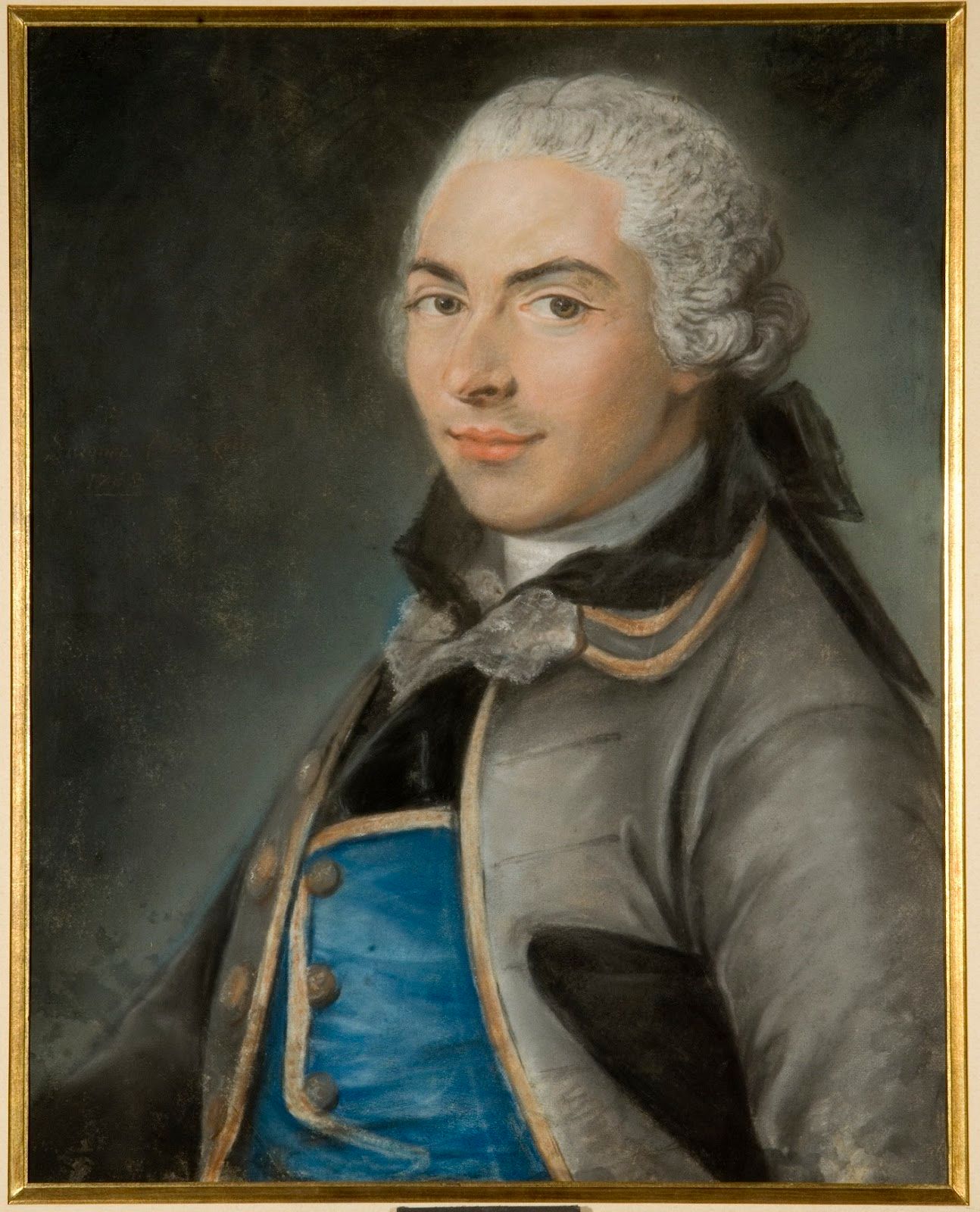
Born into a family of Bordeaux shipowners, André Daniel Laffon de Ladebat (1746 - 1829) is known for his commitment to the abolition of the slave trade. His “Discourse on the Necessity and the Means of Abolishing Slavery in the Colonies” was read at a public session of the Bordeaux Academy in 1788, and several years later in Paris at the Legislative Assembly, to which he was elected President on July 22, 1792. Conversely, his father was knighted in 1764 for his zeal as a slave trader.
Suzanne Caron (c. 1734 - c. 1777) (attributed to)
Portrait of André-Daniel Laffon de Ladebat
c. 1765 Pastel on paper, 74 x 62 cm
Bordeaux, Musée d’Aquitaine, Accession No. 2010.5.1
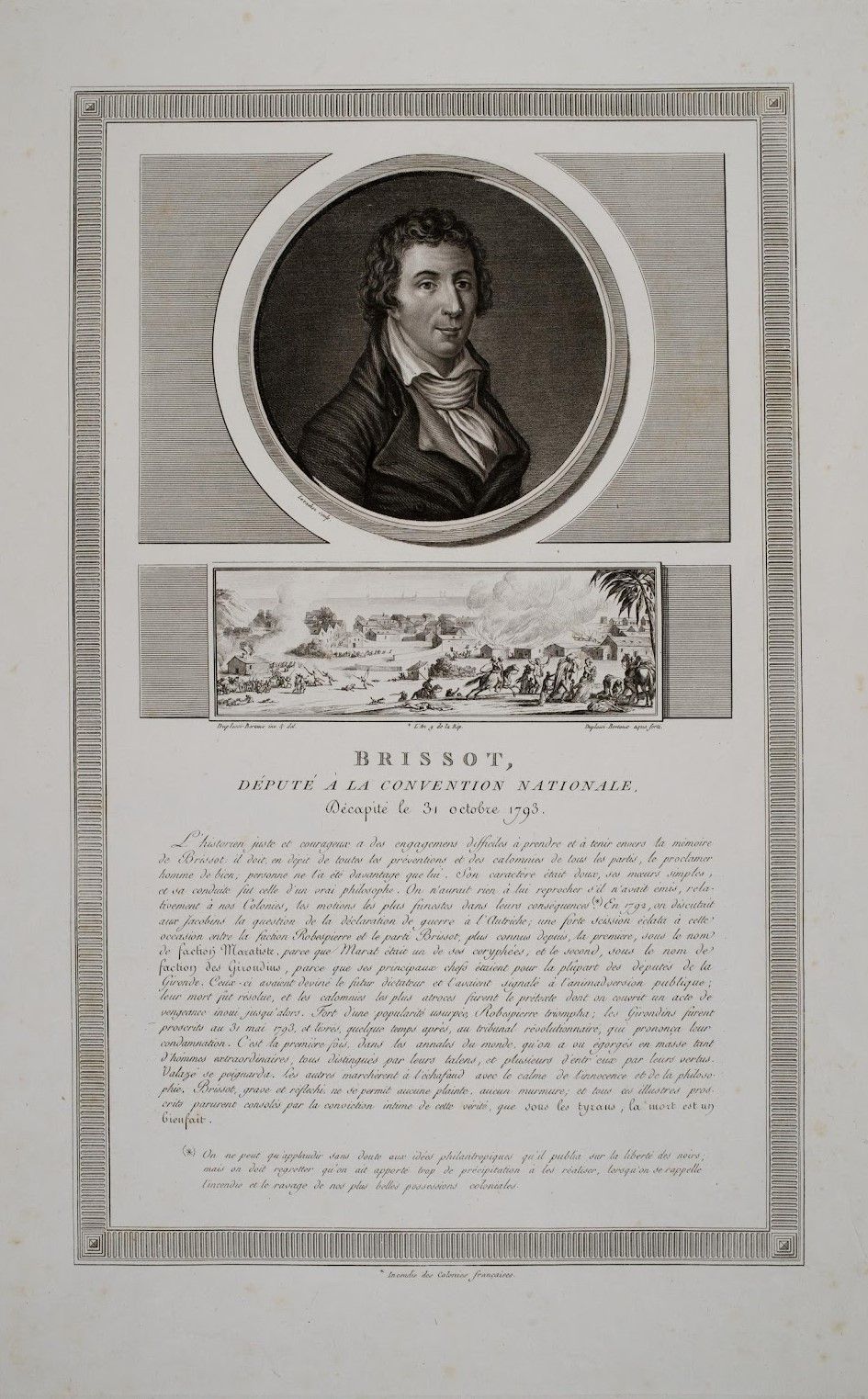
Jacques Pierre Brissot (1754 - 1793), a deputy in the Girondin party at the National Convention, founded the “Société des Amis des Noirs” (Society of the Friends of the Blacks). While many praised his views on the emancipation of slaves, all hold him directly responsible for the devastation caused by the early days of the Haitian Revolution, described here in a cartouche showing the burning of dwellings in 1791.
Portrait by Levacher, vignette by Duplessis-Bertaux Brissot, deputy in the National Convention Ninth year of the Republic (1800 - 1801) Print, 44 x 28 cm
Bordeaux, Musée d’Aquitaine, Accession No. 2010.5.1
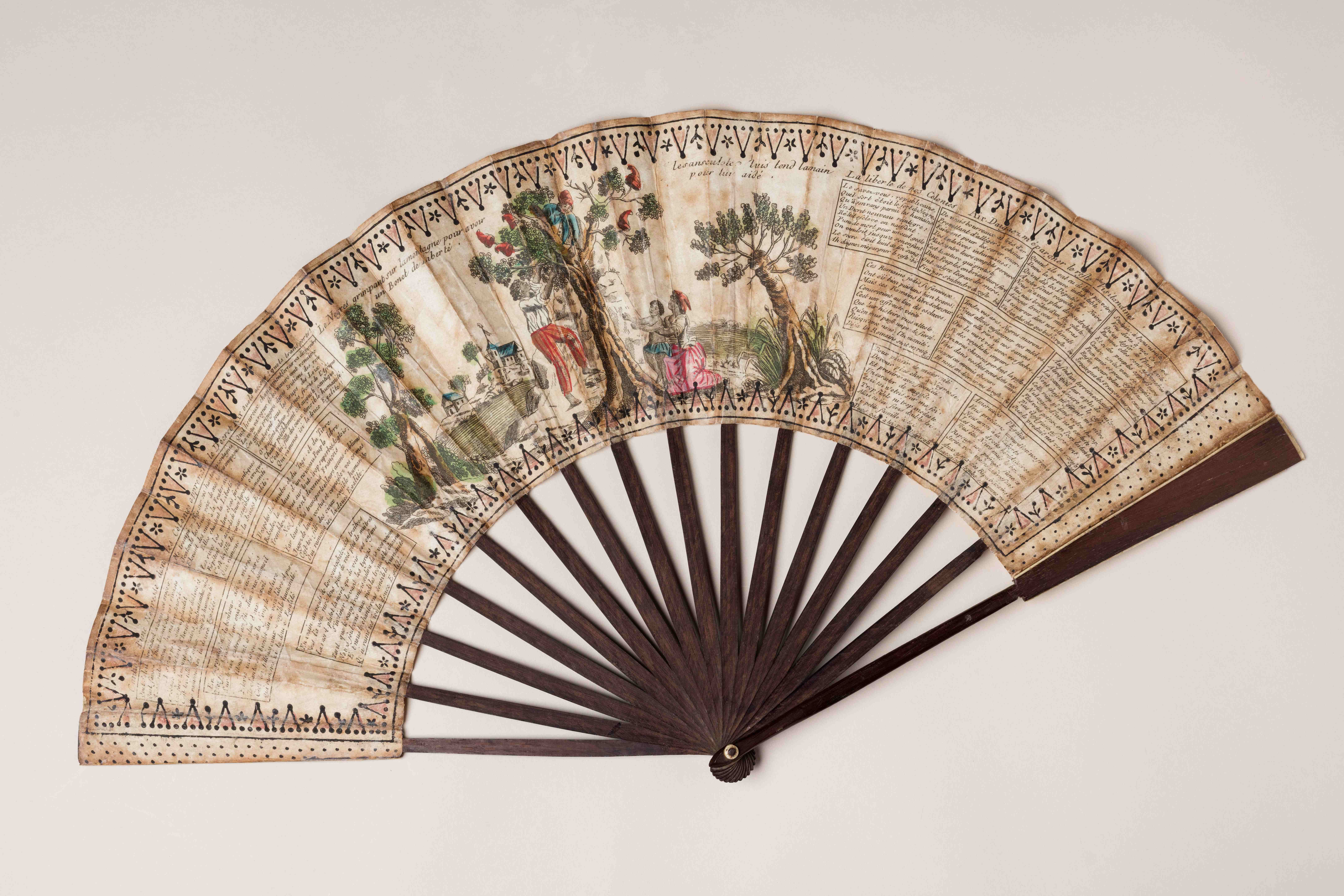
In the name of the great revolutionary principles, some everyday items became a medium in supporting the abolitionist cause. This fan celebrates the decree of 1794, probably as soon as it was published. The lyrics of the song “The Freedom of the Negroes” are written on it. The song was invented by Antoine-Pierre-Augustin de Piis - a descendant of a colonist - who settled in Saint-Domingue in the days following the decree. We can read on it: “Do you know, republicans / What was the fate of the Negro / Whom a new decree restored ! / He was born a slave / Punished with death for a single gesture / Even his child was sold / Sugar was dyed with his blood / Ah, please spare me the rest (bis)”.
Notice : © Château des ducs de Bretagne – Musée d’histoire de Nantes
Fan
After February 4th, 1794 (16 Pluviose An 2),
Circa 1794
Wood, paper, gouache, 28 x 52.5 x 2 cm
Château des Ducs de Bretagne - Musée d’Histoire de Nantes, INV 2018.11.2
Purchase
Crédit photo : ©François Lauginie / Château des ducs de Bretagne - Musée d'histoire de Nantes